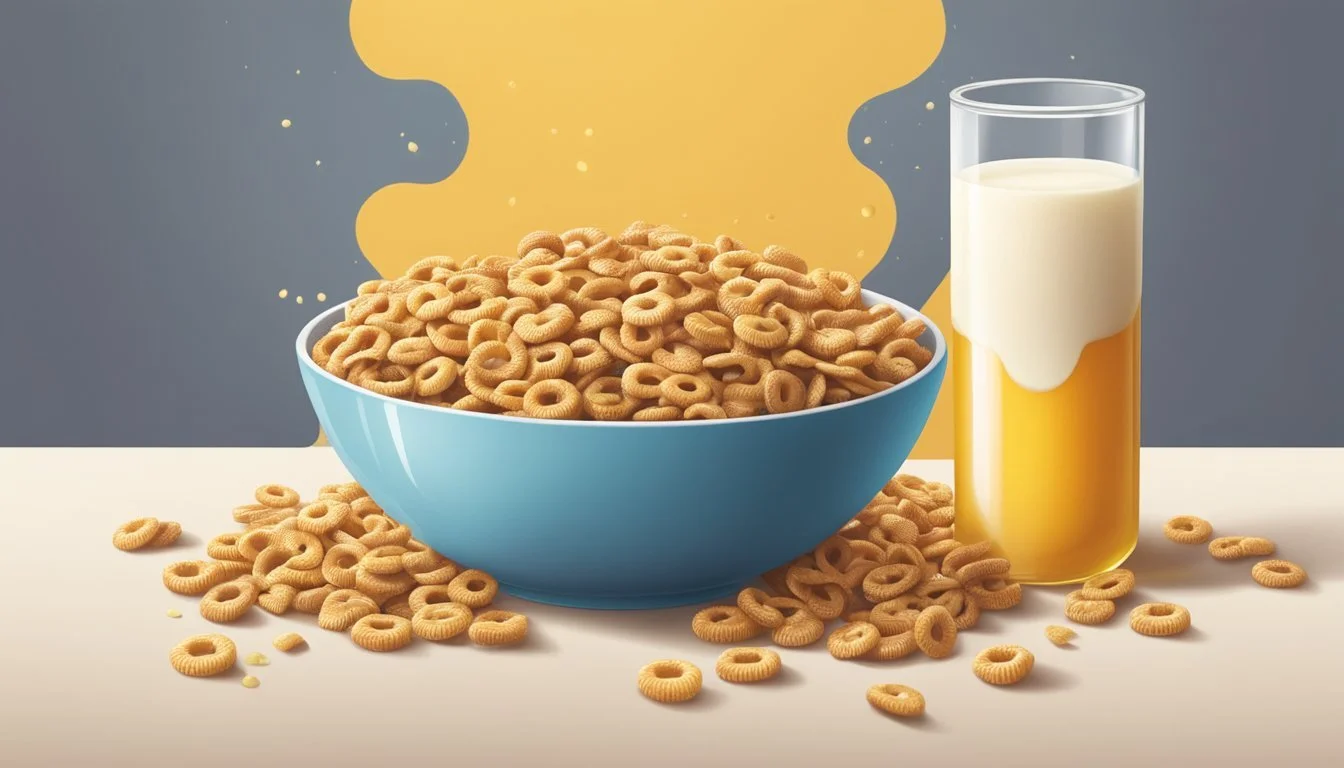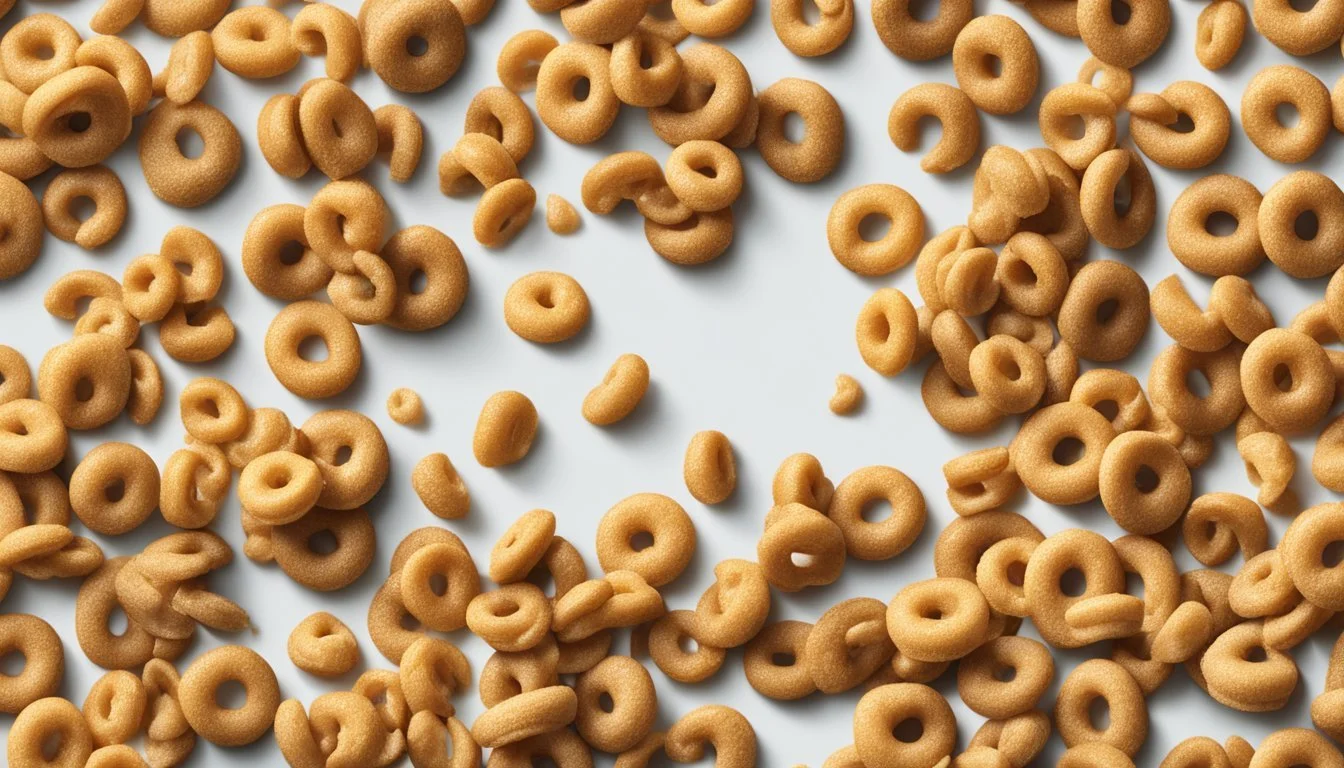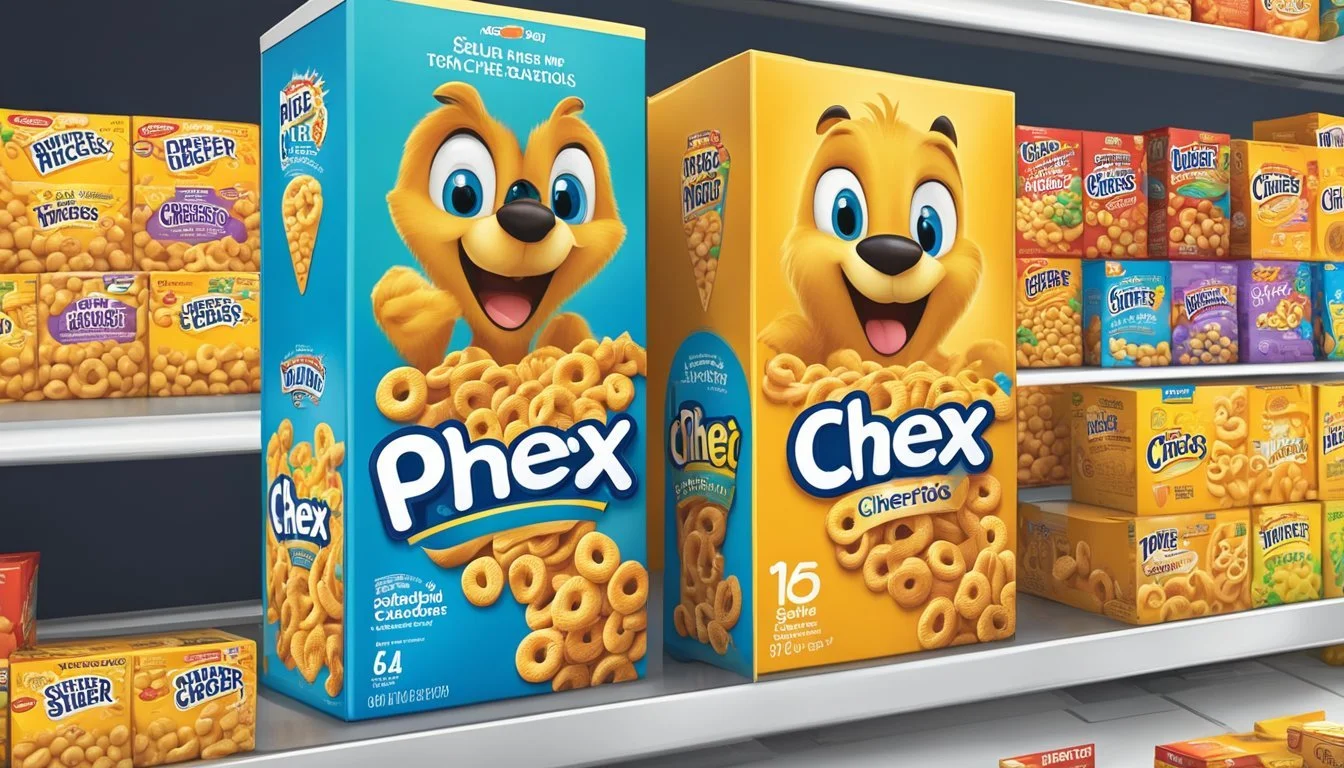Chex vs Honey Nut Cheerios
Breakfast Battle Analyzed
This Article is Part of Our Breakfast Cereal Guide with Details on Chex Nutrition and Honey Nut Cheerios Nutrition
When deciding between Corn Chex and Honey Nut Cheerios, it's essential to consider the nutritional content and how each fits into a balanced diet. Corn Chex offers a higher amount of complex carbohydrates per serving with 22 grams, compared to Honey Nut Cheerios, which contains 11.5 grams. This makes Corn Chex a better option for those seeking sustained energy release.
On the other hand, Honey Nut Cheerios, with its sweet flavor, provides a moderate intake of calories and fat per serving, making it a popular choice for breakfast enthusiasts. With only 1 gram of fat per cup, it caters to those who are conscious of their fat consumption while enjoying a sweetened cereal.
Considering protein content, both Corn Chex and Honey Nut Cheerios provide 2-3 grams per serving, making them relatively comparable in this aspect. For those closely monitoring their sodium intake, it’s worth noting that Honey Nut Cheerios contains 250 mg of sodium per serving, whereas Corn Chex is typically lower. This information will help make an informed choice based on specific dietary needs and taste preferences.
Overview of Chex and Honey Nut Cheerios
Chex and Honey Nut Cheerios are popular cereals produced by General Mills. These cereals are well-known for their unique flavors and nutritional profiles.
Honey Nut Cheerios offers a sweet taste with hints of honey and almond. It's favored for its appealing flavor but contains more sugar per serving compared to other cereals. One serving has 9 grams of sugar.
Corn Chex and Rice Chex provide options for those looking for less sweet and gluten-free choices. Corn Chex has 22 grams of complex carbohydrates per serving. Rice Chex offers a light and crispy texture.
Nutritional Comparison:
Cereal Complex Carbohydrates (g/serving) Sugar (g/serving) Honey Nut Cheerios 11.5 9 Corn Chex 22 Varies Rice Chex Varies Varies
Chex cereals are typically lower in sugar and provide a different texture and taste experience. They are also frequently used in snack mixes due to their versatility.
Overall, both Honey Nut Cheerios and Chex have their distinct characteristics, which cater to varying taste preferences and dietary requirements.
Nutritional Profile Comparison
When evaluating the nutritional profiles of Corn Chex and Honey Nut Cheerios, there are distinct differences in their calorie content, macronutrients, sugar levels, fiber content, and vitamin and mineral content. These aspects are crucial to consider for making an informed choice.
Calorie Content
Corn Chex and Honey Nut Cheerios vary in their caloric density.
Corn Chex provides 120 calories per serving, making it a relatively low-calorie option. Honey Nut Cheerios, on the other hand, contain 140 calories per serving.
For individuals watching their calorie intake, Corn Chex may be the preferred choice.
Macronutrients
The macronutrient composition of Corn Chex and Honey Nut Cheerios also differs significantly.
Protein:
Corn Chex: 2 grams per serving
Honey Nut Cheerios: 3 grams per serving
Fat:
Corn Chex: 0.5 grams per serving
Honey Nut Cheerios: 1.5 grams per serving
Carbohydrates:
Corn Chex: 26 grams per serving
Honey Nut Cheerios: 22 grams per serving
Corn Chex is higher in carbohydrates but lower in fat compared to Honey Nut Cheerios. The protein content is slightly higher in Honey Nut Cheerios, making it marginally better for protein intake.
Sugar Levels
Sugar content is a key differentiator between these cereals.
Corn Chex has 2 grams of sugar per serving. In contrast, Honey Nut Cheerios contain 9 grams of sugar per serving, which is significantly higher.
Those concerned with sugar intake, especially added sugars, may prefer Corn Chex due to its lower sugar content.
Fiber Content
Fiber content is essential for digestive health.
Fiber:
Corn Chex: 1 gram per serving
Honey Nut Cheerios: 2 grams per serving
Honey Nut Cheerios offer more dietary fiber. This fiber helps in maintaining digestive health and may contribute to a feeling of fullness.
Vitamin and Mineral Content
Both cereals are fortified with essential vitamins and minerals, but the concentrations differ.
Corn Chex:
Iron: 45% of daily value (DV) per serving
Calcium: 10% DV per serving
Honey Nut Cheerios:
Iron: 25% DV per serving
Calcium: 10% DV per serving
Zinc and Vitamin C included but in lesser quantities
Corn Chex provides a higher percentage of the daily value for iron, making it a better option for individuals looking to boost their iron intake. Both cereals offer 10% DV of calcium.
In conclusion, Corn Chex is preferable for lower calorie and sugar content, while Honey Nut Cheerios score better in protein, fiber, and overall nutrient density.
Health Considerations
Both Corn Chex and Honey Nut Cheerios offer distinct nutritional benefits, though they also have areas where one might be healthier than the other. Key factors include complex carbohydrates, whole grains, sugar content, and other nutritional components.
Health Benefits
Corn Chex contains 22 grams of complex carbohydrates per serving. Complex carbohydrates are beneficial for energy levels and can help maintain steady blood sugar. This cereal is also low in sugar, making it a healthier option for those monitoring their sugar intake.
Honey Nut Cheerios offers 22 grams of carbohydrates and 9 grams of sugar. It is touted for containing whole grain oats, which are linked to heart health. Whole grains have been recognized for their role in lowering cholesterol, partly due to their high fiber content.
Both cereals can be part of a healthy breakfast, but Corn Chex tends to be lower in sugar, which may be favorable for certain dietary needs.
Dietary Recommendations
For those following the FDA's dietary guidelines, whole grains are essential. General Mills Cheerios has a reputation for meeting these guidelines by providing whole grain oats. This makes Honey Nut Cheerios a beneficial choice for heart health. However, the higher sugar content in Honey Nut Cheerios may be a concern for some.
Corn Chex is a strong candidate for those needing lower sugar content in their diet. It provides a substantial amount of complex carbohydrates, which can support long-term energy without the sugar spike. This cereal could be ideal for those focusing on a low-sugar and high-energy diet.
Both cereals can fit into a balanced diet, depending on individual health goals and dietary restrictions. Choices should reflect personal health needs, recommendations, and preferences.
Flavor Profile and Taste
Chex and Honey Nut Cheerios offer distinct flavor experiences.
Honey Nut Cheerios have a sweet, nutty flavor enhanced by the use of honey and almond flavoring. Each bite provides a pronounced sweetness that appeals to those with a preference for sugary cereals.
Chex, on the other hand, varies significantly depending on the specific type. Corn Chex has a mild, slightly sweet flavor derived from corn. Rice Chex offers a subtler taste, which some describe as slightly nutty and bland relative to sugary cereals.
Texture also plays a crucial role in the taste experience. Honey Nut Cheerios are crunchy, but they soften quickly in milk, creating a pleasant combination of textures in a bowl.
Chex cereals maintain a crunchier texture for a longer period when immersed in milk, offering a different mouthfeel, especially appreciated in snack mixes and recipes.
Sweetness Comparison:
Cereal Sweetness Level Honey Nut Cheerios High Corn Chex Mild Rice Chex Very Mild
Those who enjoy sweeter cereals may gravitate toward Honey Nut Cheerios for their sugary flavor. Conversely, Chex offers versatility, catering to diverse taste preferences from mild to more neutral flavors.
This difference in flavor profiles allows each cereal to serve different culinary needs and taste preferences.
Serving Size and Cereal Consumption
For individuals comparing the nutritional aspects of Corn Chex and Honey Nut Cheerios, understanding serving sizes and typical consumption patterns is crucial. These metrics help gauge the impact of each cereal on a healthy breakfast routine.
Suggested Serving Size
The recommended serving size for Corn Chex is 1 cup, which weighs around 30 grams or about 1 ounce. In contrast, Honey Nut Cheerios typically suggest a serving size of 3/4 cup, approximately 28 grams.
Serving size plays an important role in managing calorie intake. For instance, Corn Chex provides 110 calories per serving, while Honey Nut Cheerios contains about 120 calories per serving. Assessing the quantities of carbohydrates, protein, and sugar in these servings can further assist in making healthier choices.
However, it's important to note that these figures can vary slightly based on the packaging and brand recommendations. Adhering to these suggested sizes helps regulate portions and ensures consistency in nutritional intake.
Typical Consumption Patterns
Despite the suggested serving sizes, actual consumption can vary significantly. Many people tend to pour more than the recommended servings, especially during breakfast. This can lead to higher intakes of calories, sugars, and other nutrients than initially planned.
For example, someone might pour 1.5 to 2 cups of cereal, which could double the intake of calories and carbohydrates. Understanding personal consumption patterns is vital for maintaining a healthy breakfast regimen.
Based on surveys and studies, children often consume larger quantities than adults. Moreover, individuals aiming for a heartier breakfast may mix multiple cereals or add ingredients like fruits and nuts, altering the nutritional profile.
Keeping track of these patterns enables better portion control and adherence to dietary goals, ensuring that the cereal remains a beneficial part of one's diet.
Price and Value
When comparing Chex and Honey Nut Cheerios, price and value are important factors for many consumers. Prices can vary depending on where the cereals are purchased.
At Walmart, a popular retail destination, the price for a standard box of Honey Nut Cheerios is typically around $3.64. For a similar-sized box of Chex, the cost is approximately $3.48.
Target also offers competitive prices. Here, a box of Honey Nut Cheerios often sells for $3.69, while Chex is priced slightly lower at about $3.49.
Both cereals come in larger family-sized boxes, which generally offer a better price per ounce. It's worth noting that generic versions of these cereals are also available and can be more affordable.
Price Summary
Store Honey Nut Cheerios Chex Walmart $3.64 $3.48 Target $3.69 $3.49
While prices are similar, your choice may depend on which store is more convenient or if there are any ongoing promotions. Additionally, the purchase of larger packages or generic alternatives can impact overall value.
In conclusion, both cereals are competitively priced, and both Walmart and Target offer them at nearly the same cost. Your decision may be influenced by store preference, ongoing deals, and the availability of larger or generic options.
Comparison to Other Breakfast Options
When comparing Chex and Honey Nut Cheerios to other breakfast options, it's essential to consider the diversity of alternatives. Both cereals face significant competition from other cereal brands and a variety of breakfast foods, each with unique nutritional profiles and flavors.
Alternate Cereal Brands
Chex and Honey Nut Cheerios differ from other cereals like Fiber One, Raisin Bran, and Special K primarily in sugar content and nutritional value.
Chex offers a range of flavors like Rice and Corn Chex, which are typically lower in sugar compared to Honey Nut Cheerios. This makes Chex an appealing choice for those looking to reduce sugar intake.
Honey Nut Cheerios contains higher sugar levels but provides a more appealing taste for those who prefer sweeter cereals.
Fiber One and Raisin Bran are high-fiber options that cater to those focused on improving digestive health. In contrast, cereals like Fruity Pebbles, Lucky Charms, and Golden Grahams are significantly higher in sugar and appeal more to children.
Cereal Sugar (g) per serving Fiber (g) per serving Chex 2-8 1-4 Honey Nut Cheerios 12 3 Fiber One 0 14 Raisin Bran 18 4-7
Other Types of Breakfast Foods
Breakfast options extend beyond cereals, incorporating foods like fruit, yogurt, toast, and special dishes.
Fruit and yogurt offer fresh, nutritious starts with natural sugars and probiotics, supporting gut health. These options are excellent for those seeking lighter, healthier breakfast choices.
Toast, especially when paired with toppings like avocado or peanut butter, provides a balanced meal combining carbs, fats, and proteins.
Other alternatives include eggs, oatmeal, and smoothies, each catering to different dietary needs and preferences.
In contrast, both Chex and Honey Nut Cheerios provide convenience and variety in taste but might be less appealing to those avoiding processed foods.
Utilizing a mix of these breakfast options can meet various nutritional goals, balancing convenience, taste, and health.
Sustainability and Brand Ethos
Chex, a product of General Mills, has made significant strides in sustainability. General Mills emphasizes corporate social responsibility (CSR) through initiatives aimed at reducing their carbon footprint. They prioritize sourcing ingredients sustainably, using renewable energy in production, and reducing waste.
Honey Nut Cheerios also reflects General Mills' commitment to sustainability and CSR. The brand strives to support bee conservation programs, recognizing the vital role bees play in pollination. Additionally, their packaging often includes information to raise awareness about environmental issues.
Both brands incorporate elements of sustainability into their production processes. General Mills works towards responsible sourcing of raw materials for both Chex and Honey Nut Cheerios. They aim to use ingredients that are grown with minimal environmental impact.
Nature's Path, mentioned in the search results, also deserves attention for its commitment to organic, glyphosate-free cereals. While not directly related to Chex or Cheerios, Nature's Path highlights the growing consumer demand for ethical and sustainable choices in cereals.
To summarize the priorities:
Ingredient Sourcing: Focus on sustainability.
Energy Use: Renewable energy in production.
Waste Reduction: Minimizing production waste.
General Mills' emphasis on CSR positively impacts both Chex and Honey Nut Cheerios, reflecting an overarching commitment to environmental stewardship and community well-being. By adopting sustainable practices, they contribute to a healthier planet and set a benchmark for the cereal industry.
More on Chex
More on Honey Nut Cheerios
Cinnamon Toast Crunch vs Honey Nut Cheerios: Which is better?
Honey Nut Cheerios vs Kellogg's Apple Jacks: Which is better?
Honey Nut Cheerios vs Kellogg's Froot Loops: Which is better?
Honey Nut Cheerios vs Post GrapevsNut Flakes: Which is better?
Honey Nut Cheerios vs Post Raisin Bran Cereal: Which is better?






